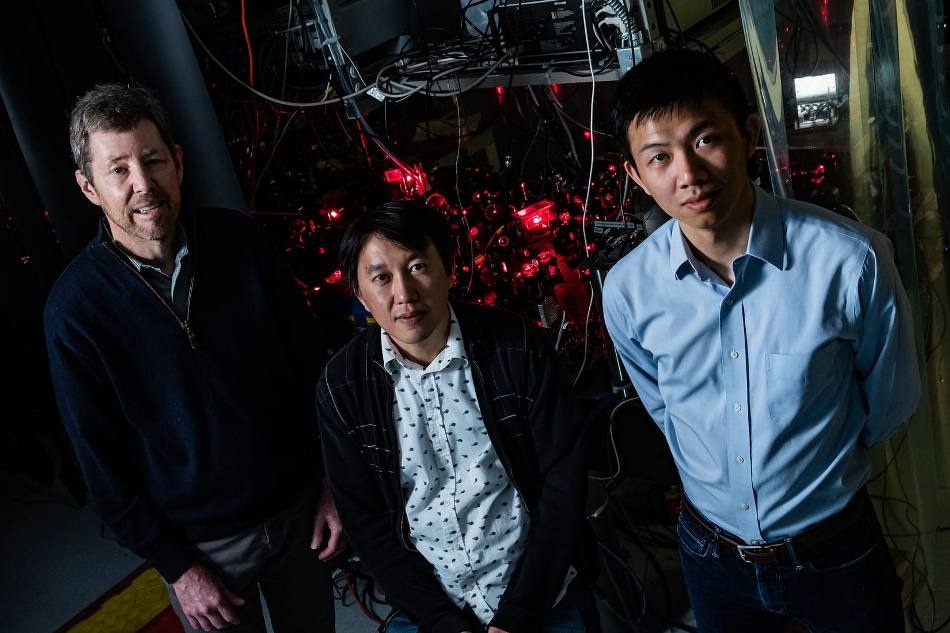Mar 26 2019
Physicists in the United States, Austria, and Brazil have demonstrated that when ultracold Bose-Einstein condensates (BECs) are shaken, they either separate into uniform segments or disintegrate into irregular splinters, based on the frequency of the shaking.
 Rice University physicists (from left) Randy Hulet, Jason Nguyen, and De Luo and colleagues in Austria and Brazil found that shaking ultracold Bose-Einstein condensates (BECs) could cause them to either divide into uniform segments or shatter into unpredictable splinters, depending on the frequency of the shaking. (Image credit: Jeff Fitlow/Rice University)
Rice University physicists (from left) Randy Hulet, Jason Nguyen, and De Luo and colleagues in Austria and Brazil found that shaking ultracold Bose-Einstein condensates (BECs) could cause them to either divide into uniform segments or shatter into unpredictable splinters, depending on the frequency of the shaking. (Image credit: Jeff Fitlow/Rice University)
“It’s remarkable that the same quantum system can give rise to such different phenomena,” stated Randy Hulet, a Rice University physicist who is the co-author of a paper related to the study published online in the Physical Review X journal on March 25th, 2019. Hulet’s lab performed the study’s experiments with the help of lithium BECs, tiny clouds of ultracold atoms that advance in lockstep as if they are a single entity, or matter wave. “The relationship between these states can teach us a great deal about complex quantum many-body phenomena.”
The study was performed in collaboration with physicists at Austria’s Vienna University of Technology (TU Wien) and Brazil’s University of São Paulo at São Carlos.
The experiments hark back to the 1831 discovery of Michael Faraday that ripple patterns are created on the surface of a fluid in a bucket that was vertically shaken at specific critical frequencies. The patterns, called Faraday waves, are analogous to resonant modes formed on vibrating plates and drumheads.
In order to analyze Faraday waves, the researchers confined BECs to a linear one-dimensional (1D) waveguide, leading to a cigar-shaped BEC. They then used a weak, slowly oscillating magnetic field to shake the BECs to modulate the strength of interactions between atoms in the 1D waveguide. The Faraday pattern appeared when the frequency of modulation was tuned close to a collective mode resonance.
However, the researchers also observed something unpredicted: When the frequency was well below a Faraday resonance and the modulation was strong, the BEC disintegrated into “grains” of different sizes. Jason Nguyen, a Rice research scientist who was the lead co-author of the study, observed that the grain sizes were widely distributed and persisted for times even longer than the modulation time.
Granulation is usually a random process that is observed in solids such as breaking glass, or the pulverizing of a stone into grains of different sizes.
Axel Lode, Study Co-author, Wolfgang Pauli Institute, University of Vienna.
Lode holds joint appointments at both TU Wien and the Wolfgang Pauli Institute at the University of Vienna.
In each Faraday wave experiment, images of the BEC’s quantum state were identical. However, in the granulation experiments, the pictures seemed to be totally different each time, although the experiments were conducted under similar conditions.
According to Lode, the difference in the granulation experiments emerged as a result of quantum correlations—complex links between quantum particles that are challenging to describe mathematically.
A theoretical description of the observations proved challenging because standard approaches were unable to reproduce the observations, particularly the broad distribution of grain sizes.
Axel Lode, Study Co-author, Wolfgang Pauli Institute, University of Vienna.
He and his colleagues helped understand the experimental outcomes using an advanced theoretical method, as well as its implementation in software, which accounted for quantum fluctuations and correlations that are not accounted for by conventional theories.
According to Hulet, Rice’s Fayez Sarofim Professor of Physics and Astronomy, and a member of the Rice Center for Quantum Materials (RCQM), the outcomes have significant implications for analyses of turbulence in quantum fluids, a problem in physics that remains unsolved.
Additional co-authors of the study are De Luo of Rice and Mario Tsatsos, Gustavo Telles, and Vanderlei Bagnato, all of the University of São Paulo at São Carlos. The Army Research Office, the Office of Naval Research, the National Science Foundation, the Welch Foundation, the Austrian Science Foundation, the Vienna Science Research and Technology Fund, and the São Paulo Research Foundation supported the study.